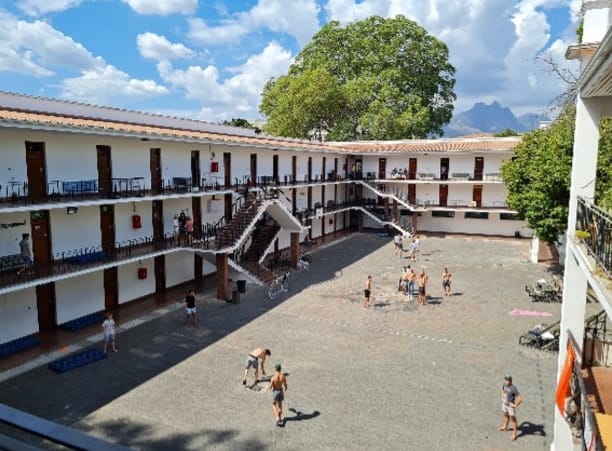In a significant move aimed at reinforcing its commitment to inclusivity and modern values, Stellenbosch University (SU) has decided to close its Wilgenhof men’s residence, which has long been a topic of controversy. This historic decision comes after a panel investigation revealed disturbing discoveries in some of the residence’s rooms earlier this year, reigniting debates about its role and history within the university.
Wilgenhof, the oldest men’s residence at Stellenbosch, has a storied past stretching back to the university’s earliest days. However, recent findings have cast a shadow over its legacy, linking it to practices that contradict the institution’s current direction towards fostering inclusivity and equality.
The Investigation and Findings
In January 2024, during an internal audit of the Wilgenhof residence, items were found in two rooms that led to a broader investigation. These discoveries brought attention to some troubling practices and symbols tied to the residence, sparking concerns about what they represented within the context of the university’s mission and values.
One of the rooms, known as “Hool 88,” had reportedly been used by the residence’s internal disciplinary committee, referred to as the Nagligte. This committee conducted its proceedings at night, and there were concerns that some of these practices may have been secretive or exclusionary in nature, raising red flags about their alignment with the university’s disciplinary standards.
Another room, called “Toe Argief,” was filled with various costumes, shoes, and paraphernalia, some of which were believed to be used in conjunction with the activities conducted by the Nagligte. These discoveries added to the sense that Wilgenhof harbored a secretive culture that could be at odds with Stellenbosch University’s efforts to cultivate a safe and welcoming environment for all its students.
In response, the university acted swiftly by removing all the items from the two rooms and repurposing the spaces. The rooms were repainted and restored to their original functions, but the controversy surrounding Wilgenhof’s past practices had already triggered a larger conversation about the residence’s future.
SU’s Decision to Close Wilgenhof
Following the audit, SU commissioned a panel to investigate further. The panel consisted of SU’s Deputy Registrar of Governance, Ethics, and Compliance, an independent advocate from the Cape Bar, and a former executive in higher education. Their findings, released in a report dated 10 June 2024, provided a clear recommendation: Wilgenhof should be permanently closed.
The report highlighted that Wilgenhof had become associated with Stellenbosch University’s troubled, racially discriminatory history. It was noted that the residence, for many, symbolized a bygone era where exclusion and inequality were more prevalent. This perception particularly resonated with black students and staff, who saw Wilgenhof as an emblem of an era that the university has been working hard to move beyond.
The panel’s report underlined that while not all aspects of the residence were problematic, its historical and cultural significance had become too controversial to overlook. In the interest of advancing the university’s goals of diversity, inclusivity, and equality, the report strongly suggested that Wilgenhof could not continue in its current form.
University Leadership Supports the Closure
SU’s rectorate, led by outgoing Vice-Chancellor Professor Wim de Villiers, unanimously endorsed the panel’s recommendation. Professor de Villiers emphasized that the decision to close Wilgenhof aligns with the university’s broader mission to create an inclusive and welcoming environment for all students, regardless of their background. He pointed out that while Wilgenhof holds historical significance, the residence’s legacy needed to be reconsidered in light of the university’s present values and future aspirations.
Before a final decision was made, Stellenbosch University invited stakeholders, including current and former students, staff members, and the broader university community, to submit written representations regarding the proposed closure. The deadline for these submissions was 31 July 2024, and they played a crucial role in shaping the university’s final decision.
On 24 June, the University Council held a meeting to review the panel’s findings and consider the stakeholder submissions. After much deliberation, the Council concluded that Wilgenhof, as it currently stands, should be closed at the end of the 2024 academic year.
What’s Next for Wilgenhof?
As Wilgenhof prepares to close its doors, SU has outlined its plans for the building’s future. The residence will undergo significant upgrades throughout 2025, ensuring that it meets the Department of Higher Education’s policy on the minimum norms and standards for student housing at public universities. These renovations are intended not only to modernize the facility but also to signal a break from its controversial past.
Once the upgrades are completed, the residence will reopen in 2026 as a male residence with a fresh identity, one that reflects the university’s commitment to progress, inclusivity, and equality. While the specific nature of the new residence’s operations has yet to be determined, it is clear that the university wants to move away from the aspects of Wilgenhof’s history that were associated with exclusionary practices.
During 2025, while the upgrades are taking place, SU is exploring alternative uses for the space. These discussions are ongoing, but the university has reassured its community that the building will continue to serve a positive role on campus during the transition period.
The closure of Wilgenhof represents a turning point for Stellenbosch University as it seeks to create a campus environment that is aligned with modern values of inclusion and respect for all. As SU continues to grow and evolve, the decision to reimagine Wilgenhof as a symbol of progress rather than controversy is a step toward a more unified and inclusive future for all its students.
The university has made it clear that this decision was not taken lightly, but it reflects a determination to ensure that the past does not hinder the institution’s efforts to build a brighter, more equitable future. As SU embarks on this journey of transformation, the closure of Wilgenhof will likely stand as a significant milestone in its broader pursuit of inclusivity and equality.









